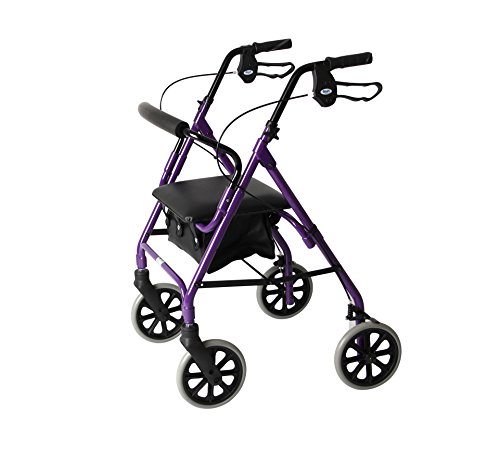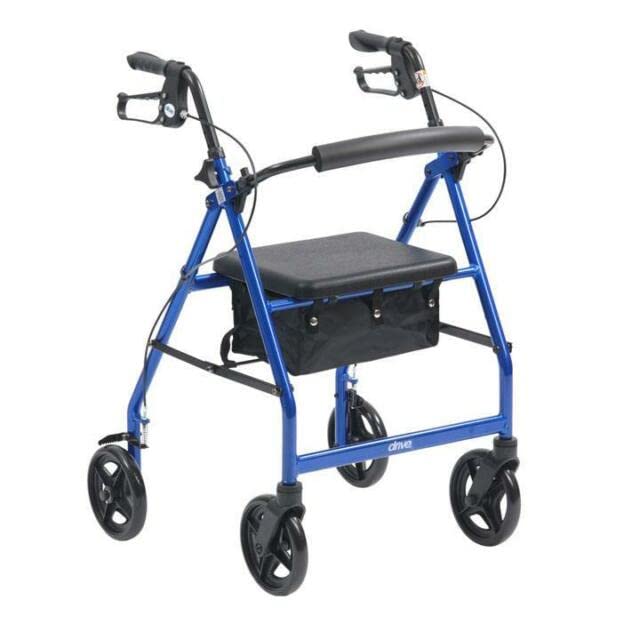Why Adding A Rollator Mobility Walker To Your Life's Activities Will M…
- 작성일24-10-04 12:28
- 조회5
- 작성자Jolene
 Rollator Mobility Walker
Rollator Mobility WalkerRollators are a good option for those with a restricted mobility who require stability when walking. They have large wheels with spaces built into the frame for seating.
This model has padded handles to provide comfort and ease pressure on the hands. It comes with adjustable height handlebars as well as intuitive loop locks that prevent the walker from moving when you're sitting or resting.
Comfort
If someone has recently sustained an injury that affects their balance and gait or recovering from knee, hip or other lower-limb surgeries or injuries, rolling walkers can help. These walking aids offer stability and support to allow users to walk more easily while keeping them active and connected to their family, friends, and community.
They are available in a variety of styles, such as the traditional walker with wheels that looks more plain than a walker with wheels. The handles of walker typically are placed at a height that is most comfortable for the user, making them ideal for those who requires a stable support, but wants to be able to move faster than a cane.
The wheels on a rolling walker allow it to be more flexible and easier to use than a standard walking device. The wheels on a rollator are more together, which makes it easier to move and steer the device in tight places. They can also be rotated to increase the speed of walking up and down the stairs. A majority of rollators come with a seat with a crossbar so that users can sit down whenever they need to.
The handles of a rollator can be made of materials that differ in thickness and texture. Look for handles that have soft texture and soft plastic grip. It is more comfortable to hold for those with arthritis. Additionally, consider whether the model you pick has loop-lock brakes or lean-activated breaks to accommodate a range of hand strength levels.
Stability
A good rollator should be comfortable and have a wide seat that users can sit on when they wish to take a break. It should have easy-to-operate brakes and ergonomic, soft grips. The grips should be cushioned and comfortable for those who have wrist or hand issues. Some models include padding for the backrest. It is recommended to choose an walker with a weight capacity that is adequate for your needs, and adjustable handles that can be adjusted to your height.
A walker with an locking mechanism is crucial for those who travel frequently or require transporting their walker into and out of vehicles. It can help prevent the walker from being accidentally opened while in transit, preventing injuries and other harm. Another thing to consider is whether the walker comes with removable and interchangeable parts so you can tailor it to your needs.
Researchers conducted a study to find out how the strategy for task-performance, and the device load affects rollator stability. The study involved ten participants who completed six tasks using an instrumented rollator. The researchers measured the combination centre of pressure and base of support that is known as the system Stability Margin (SM). The team found that SM decreased significantly when a person was asked to complete other tasks besides straight line walking. They also found that a user's leaning onto the device increases the centre of pressure at the base of support and can alter stability or increase it. The researchers conclude that their findings can be utilized to improve rollator foldable training. They suggest that a greater focus should be given to activities that are not straight line walking, and on the specific strategies for performance of each task which can help or hinder stability.
Capacity to bear weight
A rollator walker is capable of supporting up to 300 pounds, or more, depending on the model. Its sturdy frame and four wheels can aid in maintaining the balance and mobility of people particularly with medical conditions or aging. Rollators are less difficult to maneuver than standard walkers that require users to lift their weight to move forward. This helps reduce hand fatigue.
Rollators come with wheels that are usually 6 to 10 inches wide. This allows them to be used indoors as well as outdoors on various surfaces. Certain models come with a variety of height settings to meet the needs of different users, while others fold for easy transport and storage. Some even feature a seat that allows users to rest while walking.
Many walkers come with a variety of accessories. For instance, a walker tray or basket for storing personal things. Additional accessories include a wrist guard to safeguard hands from injury and a walker bag to carry additional items. Some walker frames are compatible with wheelchairs, making them easy to change when one's mobility needs change.
A bariatric rollator is constructed with a sturdy frame and a larger seat to accommodate larger individuals. It comes with adjustable height handles as well as a padded backrest that is wide as well as locking hand brakes to provide the highest level of security and safety. The angled handlebars keep the hands in a neutral, stress-free position. The convenient storage strap allows it to be easily tucked to a trunk of a vehicle. The 8" wheels feature anti-tip technology that provides stability and a greater maneuverability. The cushioned seat provides an ideal spot to rest while on the move.
Brakes
A rollator works differently than a standard walker. Instead of having all terrain walker rollators four legs touch the ground, a rollator has wheels that are controlled by hand brakes that are located below or embedded into the handlebars. This design makes it easier to navigate small spaces and to make sharp turns left or right. The brakes may become difficult to operate or loose, which can be a risk to those with limited strength and declining mobility.
Many manufacturers provide the option of adding brakes that can also be locked to improve safety and stability. This feature is particularly beneficial for those who have difficulty getting the brakes to squeeze or applying pressure due to a weak grip or other health issues such as arthritis. Although there are some variations in the way that locking brakes are adjusted, the majority of walkers follow the same steps to ensure a proper adjustment.
It is essential to read the maintenance instructions that come with your mobility device for specific instructions prior to attempting to adjust lock brakes. To begin you must find the knob to adjust the brake or screw typically positioned near the handle grips and tighten it by rotating it clockwise. This is essential because if you don't tighten the adjuster correctly it will be impossible to remove the slack in the brake cable. Then tighten the lower cable adjuster with the same procedure. After you have completed these adjustments test the brakes by pressing them gently and see if they respond properly. If they aren't then the locking mechanism is likely not working properly.
Accessories
 There are a number of accessories for the rollator walker Tall walker, such as baskets and cup holders. Some are useful for carrying things while walking. Others such as the Mobility Phone Grip, clip onto the bars on the vertical sides of a wheelchair or walker and expand to hold a smartphone. The grips can also swivel and adjust to the ideal height for holding the device. Many of these accessories are made to be light and simple to use, and ideal for those with arthritis.
There are a number of accessories for the rollator walker Tall walker, such as baskets and cup holders. Some are useful for carrying things while walking. Others such as the Mobility Phone Grip, clip onto the bars on the vertical sides of a wheelchair or walker and expand to hold a smartphone. The grips can also swivel and adjust to the ideal height for holding the device. Many of these accessories are made to be light and simple to use, and ideal for those with arthritis.Most walker and rollator manufacturers offer a range of handle heights, so you can choose the best rollator wheelchair combo one for your body type. Take into consideration the weight capacity when selecting a rollator. This will impact how well it will work for you. While most folding rollators are designed to help those who weigh between 300 and 300 pounds, some manufacturers provide models that can accommodate up to 500 pounds.
Another feature to consider when selecting a walker or rollator is the kind of brakes it comes with. The brakes that are pushed down work by applying downward pressure to the frame to stop forward motion. Loop brakes are similarly designed, however, they require simultaneous use of both hands and more physical strength to apply. Both kinds of brakes are an essential safety feature, and it's important to find the best option for your needs.
See a doctor, a physical therapist or occupational therapist if unsure of which type of walker or rollercaster is most suitable for you. They can provide advice on the features that would be most beneficial for your particular situation, and help you choose the right model that is compatible with any other equipment you have at home or stored.
등록된 댓글
등록된 댓글이 없습니다.
